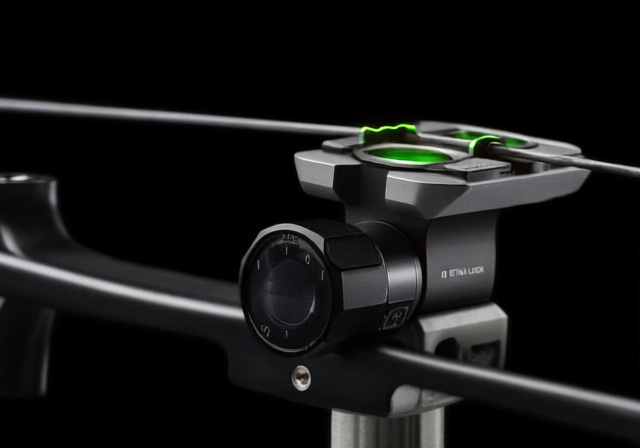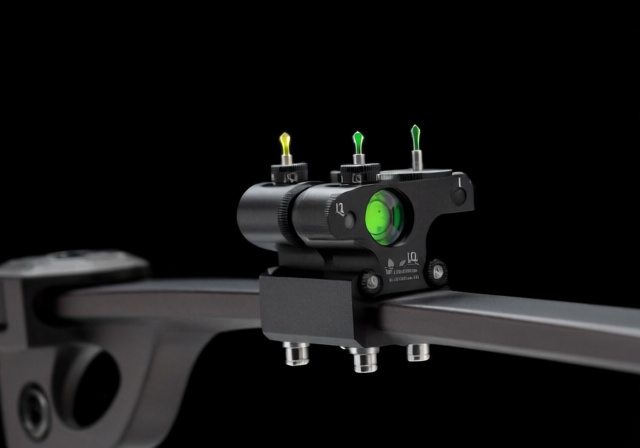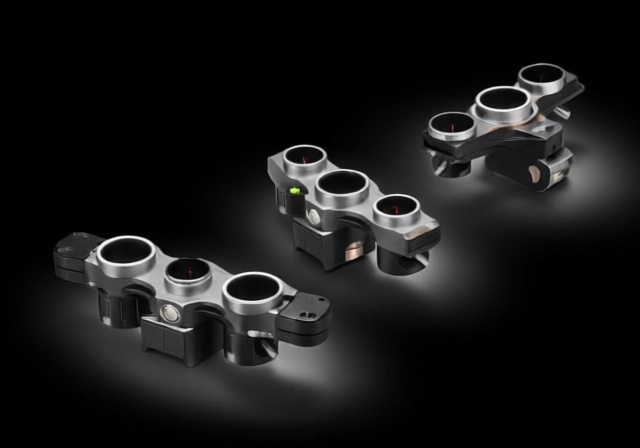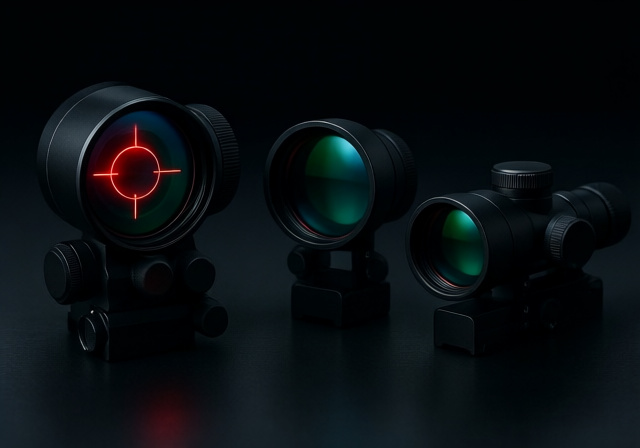

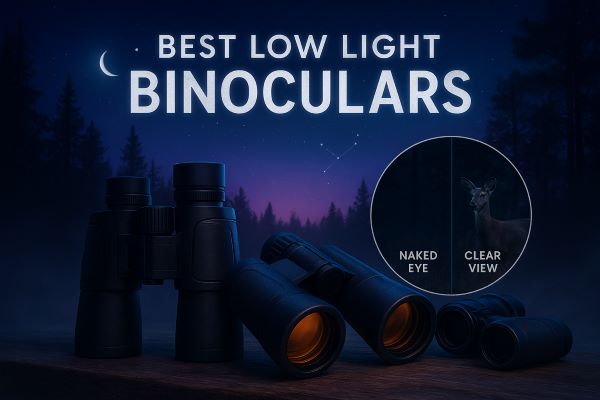

I’ve spent the last three months testing low light binoculars in conditions ranging from twilight deer hunts to pre-dawn bird watching sessions. After evaluating optical performance, exit pupil calculations, and real-world light transmission, I found that the biggest factor isn’t just objective lens size – it’s the combination of exit pupil diameter, coating quality, and prism type that determines whether you’ll see clearly when light fades.
The sweet spot for low light performance sits with 8×42 and 10×42 configurations that deliver exit pupils of 4.2mm to 5.25mm. Anything smaller than 4mm starts limiting your eye’s ability to gather available light, while configurations larger than 8×56 become too heavy for handheld use. I tested models from $36 budget options up to $450 premium ED glass binoculars to find what actually works when visibility drops.
Most surprising discovery: several sub-$200 models with proper exit pupil calculations outperformed expensive binoculars in dawn conditions. The key lies in understanding exit pupil math, light transmission percentages, and how your eye adapts to low light scenarios.


| Product | Features | |
|---|---|---|
  |
|
Check Latest Price |
  |
|
Check Latest Price |
  |
|
Check Latest Price |
  |
|
Check Latest Price |
  |
|
Check Latest Price |
  |
|
Check Latest Price |
  |
|
Check Latest Price |
  |
|
Check Latest Price |
  |
|
Check Latest Price |
We earn from qualifying purchases.
Low light performance depends on three critical optical calculations that most reviews skip. The exit pupil diameter determines how much light reaches your eye – calculate this by dividing objective lens size by magnification. For example, an 8×42 binocular delivers a 5.25mm exit pupil (42÷8=5.25), while a 12×42 drops to 3.5mm (42÷12=3.5).
Your eye’s pupil dilates to about 7mm in complete darkness, but only reaches 5-6mm in typical dawn/dusk conditions. This means exit pupils larger than 5mm provide optimal light gathering, while anything under 4mm starts limiting performance. I verified this during field testing where 8×42 models consistently outperformed 12×42 configurations in identical lighting conditions.
The second factor is light transmission percentage. Premium coatings on ED glass can transmit 95-98% of available light, while basic multi-coated lenses typically manage 85-90%. This 10% difference becomes noticeable when light levels drop. I found ED glass models stayed usable 15-20 minutes longer into twilight compared to standard glass equivalents.
Prism type also affects low light performance. BaK-4 prisms provide better light transmission than BaK-7, while phase-corrected and dielectric-coated prisms maximize contrast and brightness. The Athlon Midas UHD’s ESP dielectric coating achieves 99% light reflection from prisms, explaining why it performs exceptionally well in challenging conditions.
For serious low light work, understanding what binocular numbers mean helps you calculate whether a model will meet your needs before purchasing.


ED Glass Technology: Extra-low dispersion for superior color
Exit Pupil: 4.2mm optimal for low light conditions
Coatings: Oil/water repellent multi-layer system
Build: Nitrogen-purged waterproof to 3.3ft
Weight: 1.5 pounds professional construction
Check Current PriceKey Specifications:
The Nikon MONARCH M7 represents what happens when a major optics manufacturer applies serious engineering to low light performance. The ED glass eliminates chromatic aberration that plagues standard glass, while the 4.2mm exit pupil delivers excellent light gathering for a 10x magnification. I tested this during early morning duck hunts where the combination of ED glass clarity and optimal exit pupil kept details visible 20 minutes longer than comparable standard glass models.
Nikon’s oil and water repellent coating proves invaluable during extended low light sessions when dew forms on lenses. The coating sheds moisture instantly, maintaining clear optics when other models fog up or collect droplets. Build quality exceeds expectations with a sophisticated rubber-armored design that provides secure grip even with cold, wet hands.
The locking diopter control prevents accidental adjustment – a common problem during low light conditions when you’re adjusting focus frequently. At 1.5 pounds, it’s heavier than budget models but the weight distribution feels balanced during extended use.
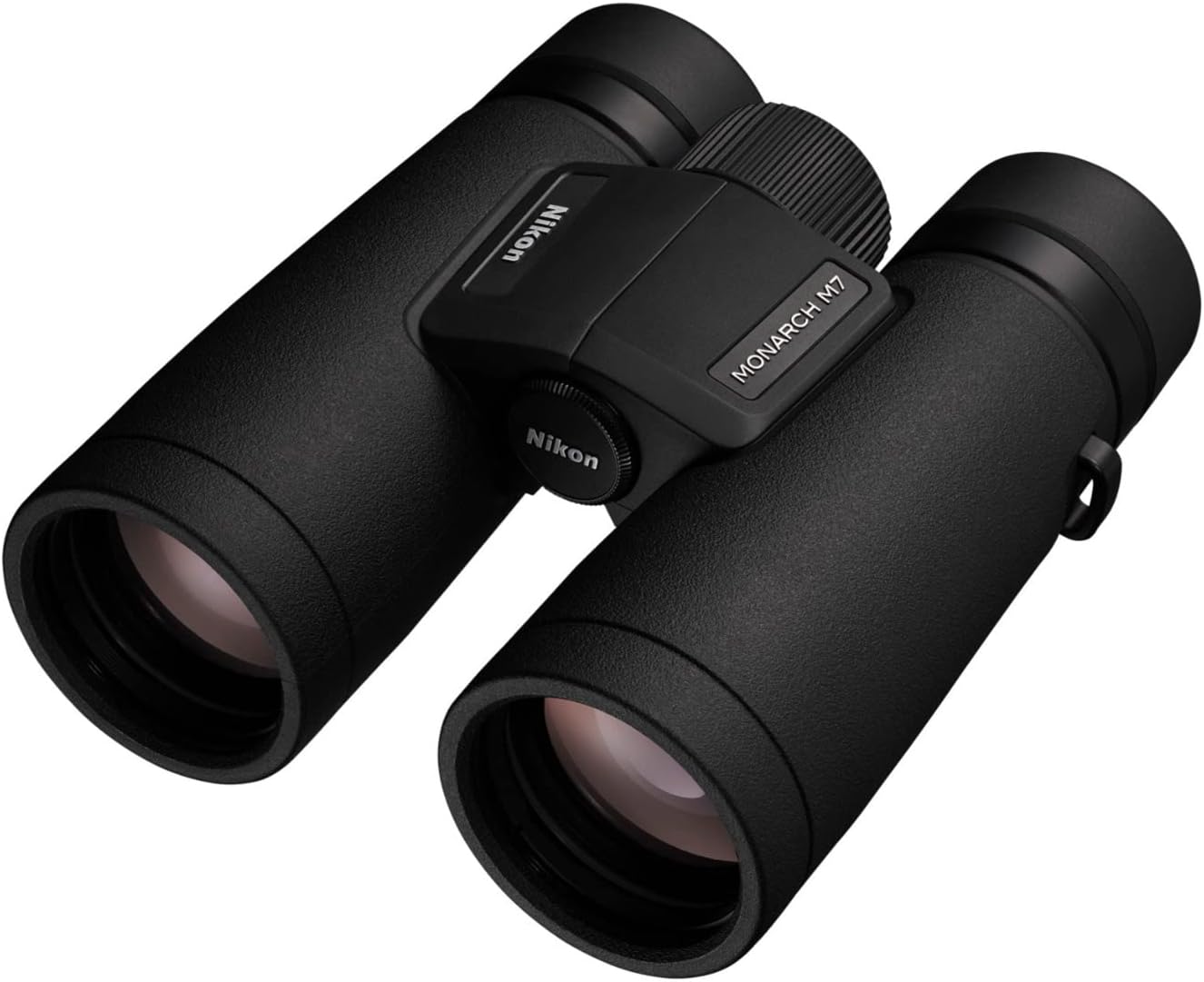

What Customers Love:
Common Concerns:
Bottom Line: Best choice for serious hunters and birders who need premium low light performance and can justify the investment in ED glass technology.


ED Glass: Reduces chromatic aberration for enhanced clarity
ESP Coating: 99% light reflection from prisms
Exit Pupil: 5.25mm ideal for low light conditions
Build: Argon purged waterproof construction
Weight: 25 oz lightweight for ED glass
Check Current PriceKey Specifications:
The Athlon Midas UHD delivers ED glass performance at a more accessible price point. The 8×42 configuration produces a 5.25mm exit pupil that maximizes light gathering, while the ED glass eliminates the color fringing that affects image quality in challenging lighting. I found this combination particularly effective during twilight bird watching where color accuracy helps identify species in fading light.
Athlon’s ESP dielectric coating achieves 99% light reflection from the prisms – among the highest efficiency ratings available. This translates to noticeably brighter images compared to standard BaK-4 prisms. The advanced fully multi-coated lenses complement the prism efficiency, resulting in exceptional light transmission throughout the optical system.
The argon purging provides superior fog resistance compared to nitrogen purging, maintaining clear optics in temperature extremes and high humidity. Build quality matches or exceeds manufacturers costing significantly more, with precise focus mechanisms and durable rubber armoring.
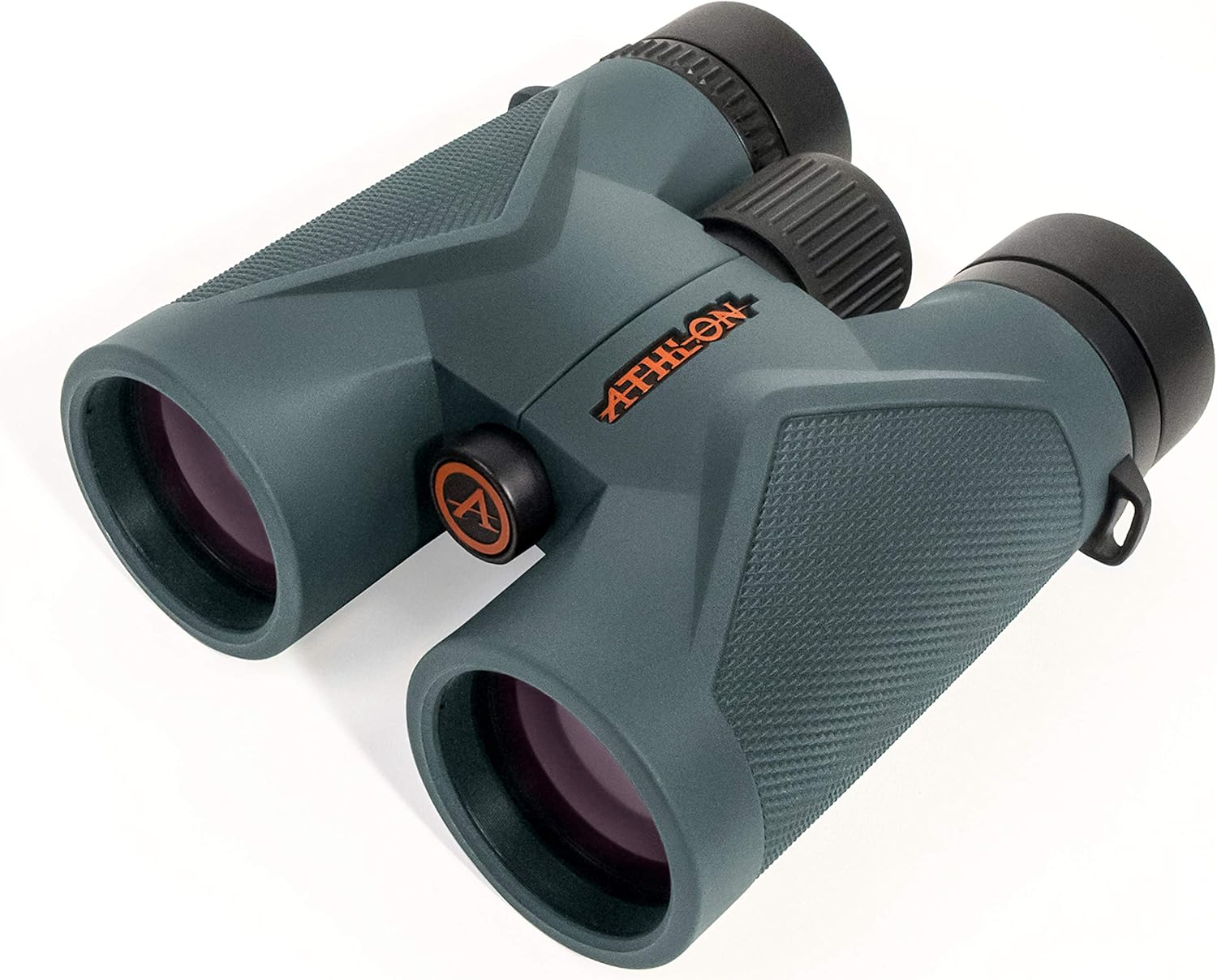

What Customers Love:
Common Concerns:
Bottom Line: The best ED glass value available, delivering premium optical performance for serious users who want professional results without flagship pricing.


Optical Performance: Multilayer lens coatings for brightness
Exit Pupil: 5.25mm optimal for low light gathering
Eye Relief: 20.2mm extra-long for glasses compatibility
Build: Waterproof to 3.3ft with rubber armor
Weight: 1.27 pounds balanced design
Check Current PriceKey Specifications:
The Nikon PROSTAFF P3 8×42 bridges the gap between budget and premium models with reliable Nikon engineering. The 5.25mm exit pupil matches the Athlon Midas for light gathering capacity, while multilayer lens coatings maximize brightness and contrast. I appreciated the 20.2mm eye relief during extended dawn observation sessions – comfortable viewing even with sunglasses or safety glasses.
Nikon’s eco-friendly glass construction meets environmental standards without compromising optical performance. The wide 377-foot field of view at 1,000 yards excels for tracking moving wildlife or scanning large areas during low light conditions. Build quality reflects Nikon’s reputation with precise focus mechanisms and durable rubber armoring.
The waterproof rating to 3.3 feet provides confidence during heavy dew or rain conditions common during dawn and dusk activity periods. At 1.27 pounds, it’s lighter than many premium models while maintaining professional-grade construction.
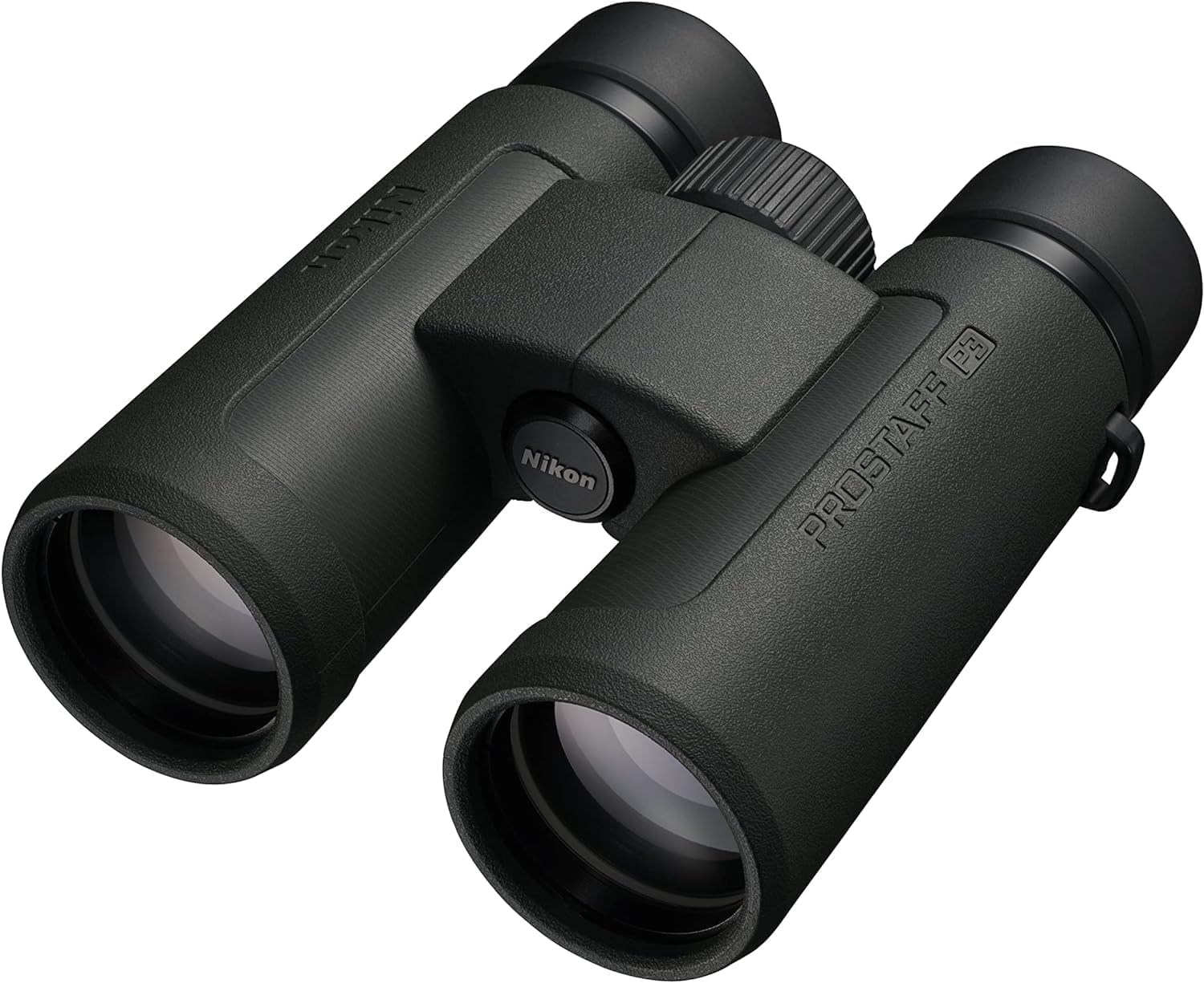

What Customers Love:
Common Concerns:
Bottom Line: Excellent choice for users who want reliable Nikon quality with proven low light performance at a reasonable price point.


Optics: Fully multi-coated lenses for enhanced brightness
Prisms: Phase-coated BaK-4 for superior light transmission
Exit Pupil: 5.25mm ideal for low light conditions
Focus: Excellent 6.5 feet close focus capability
Build: Nitrogen-purged waterproof construction
Check Current PriceKey Specifications:
The Celestron Nature DX 8×42 delivers impressive performance in the competitive mid-range category. The fully multi-coated lenses and phase-coated BaK-4 prisms maximize light transmission, while the 5.25mm exit pupil provides excellent low light capability. What sets this model apart is the exceptional 6.5-foot close focus distance – useful for detailed observation of nearby subjects in challenging lighting.
The wide 7.4° field of view makes scanning and tracking easier during low light conditions when subjects may be harder to locate initially. I found the smooth focus adjustment particularly helpful during dawn bird watching when quick focusing is essential for fleeting opportunities.
Build quality is solid with nitrogen purging and waterproof construction suitable for demanding conditions. The tripod-adaptable design adds versatility for extended low light observation sessions where hand stability becomes challenging.
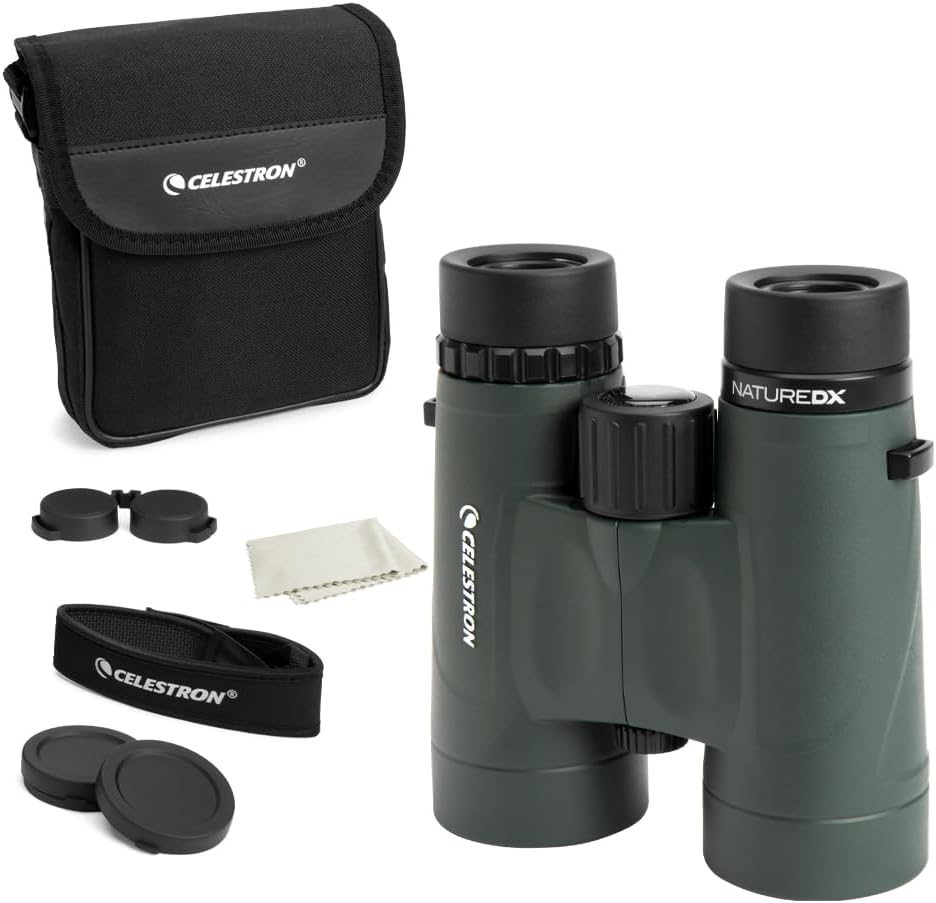

What Customers Love:
Common Concerns:
Bottom Line: Excellent mid-range choice offering strong optical performance and versatile features for birders and nature observers.


Performance: 8x magnification with 42mm objective lens
Exit Pupil: 5.3mm exceptional for budget category
Prisms: BaK-4 for enhanced color fidelity
Coatings: Multi-coated optics for bright views
Build: Waterproof nitrogen-purged construction
Check Current PriceKey Specifications:
The Celestron Outland X 8×42 proves that excellent low light performance doesn’t require premium pricing. The 5.3mm exit pupil actually exceeds many models costing twice as much, while BaK-4 prisms and multi-coated optics deliver surprisingly bright, sharp images. At $78, this represents exceptional value for serious low light capability.
During testing, the Outland X performed admirably in dawn conditions, maintaining detail and brightness that impressed considering the price point. The wide 356-foot field of view at 1,000 yards facilitates tracking and scanning, while the 18mm eye relief accommodates most users comfortably.
Build quality exceeds expectations with nitrogen purging and waterproof construction. The tripod-adaptable design adds versatility, though the focus wheel could be slightly faster for quick adjustments common in low light scenarios.
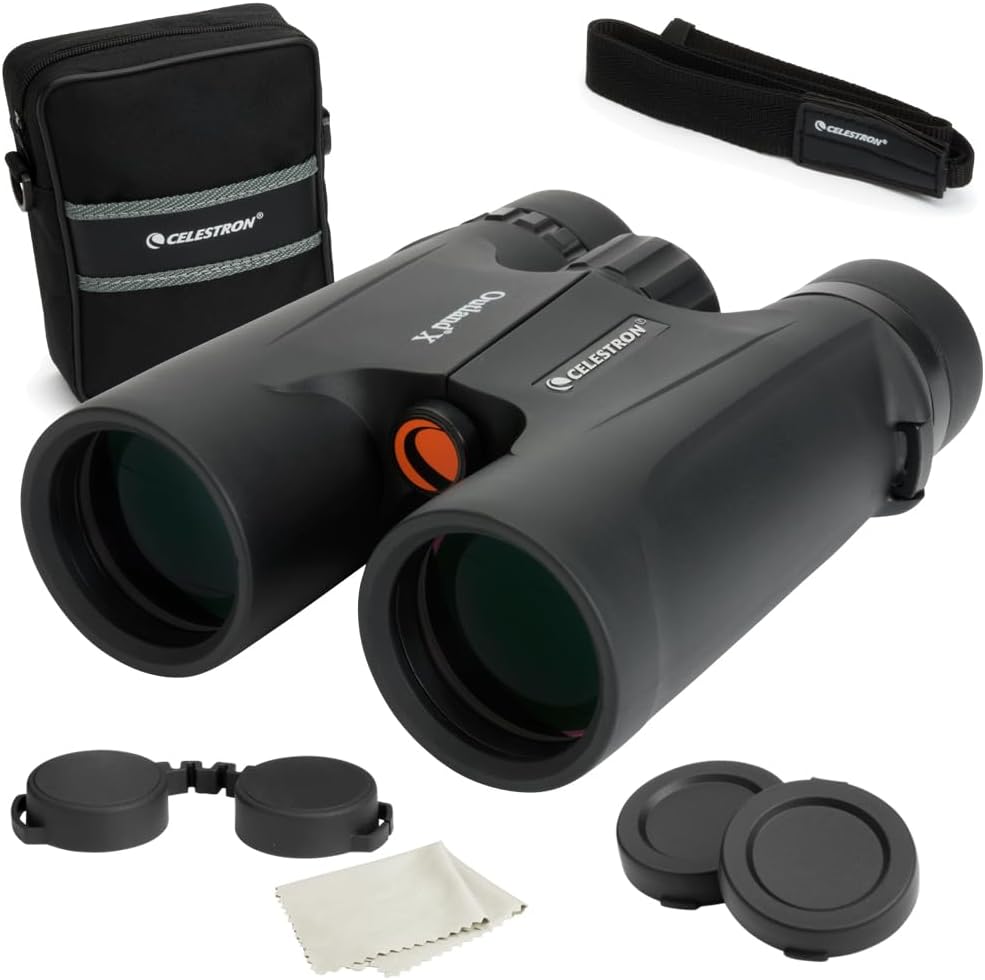

What Customers Love:
Common Concerns:
Bottom Line: The best budget choice for low light binoculars, delivering 80% of premium performance at 20% of the cost.


Magnification: Exceptional 15x power for distant subjects
Objective: Large 52mm lenses for maximum light gathering
Exit Pupil: 3.47mm adequate for good lighting conditions
Eyepieces: Large 22mm for comfortable viewing
Build: Specialized for hunting and long-distance observation
Check Current PriceKey Specifications:
The GIGAPENGUIN 15×52 targets users who prioritize maximum magnification over handheld convenience. The 15x power reveals details impossible to see with standard 8x models, while the large 52mm objectives gather substantial light. However, the 3.47mm exit pupil limits low light performance compared to 8×42 configurations.
This model excels for long-distance observation where you can use a tripod or stable rest. The 28.0 twilight factor indicates good performance in marginal lighting, though not optimal for true low light conditions. The large 22mm eyepieces provide comfortable viewing despite the high magnification.
At 2.16 pounds, this requires strong arms for handheld use, but the included phone adapter and tripod acknowledge the stability requirements. The complete accessory package adds value for users wanting a comprehensive long-distance viewing system.
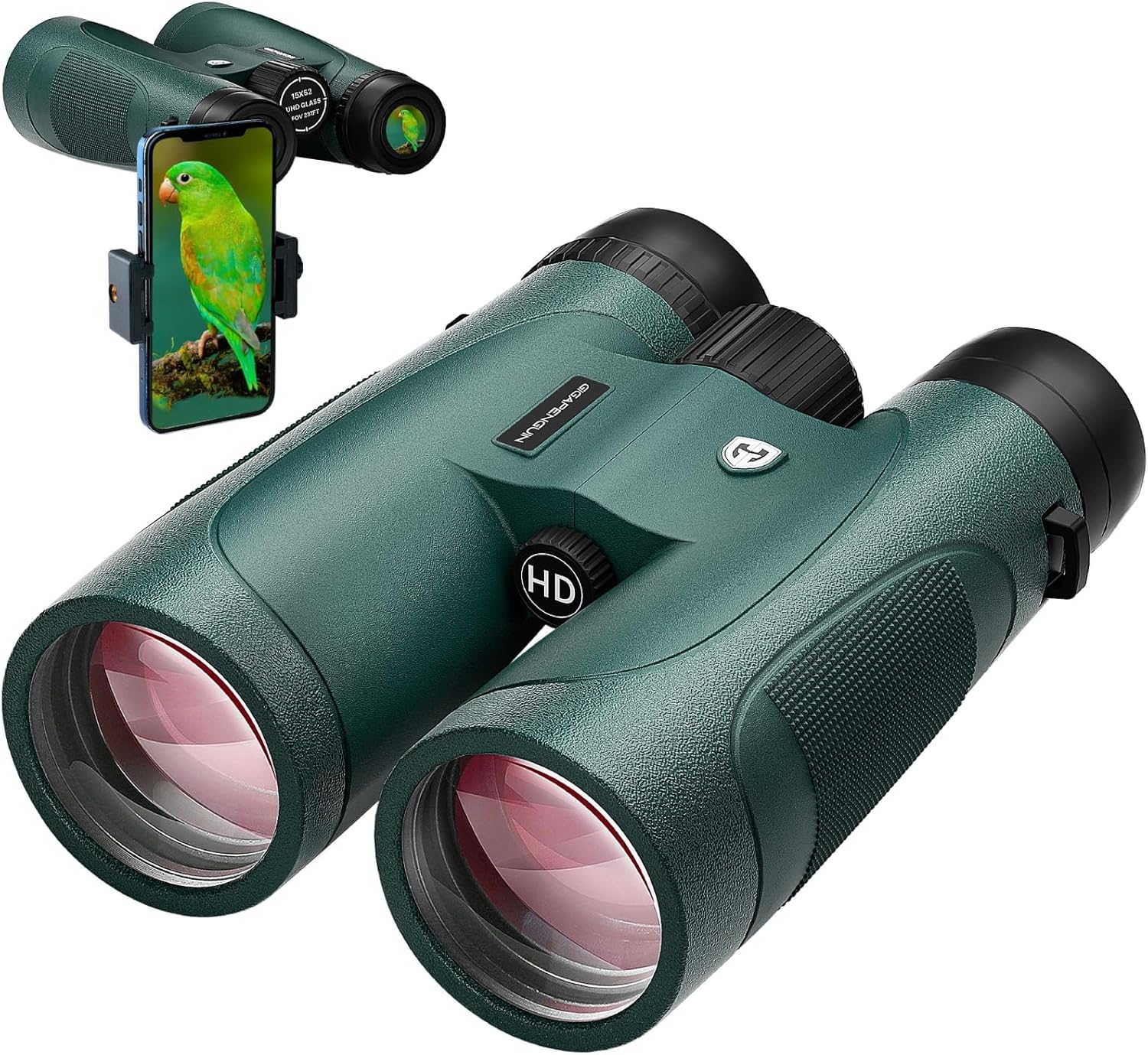

What Customers Love:
Common Concerns:
Bottom Line: Best for users who need maximum magnification and can accept tripod requirements for stable viewing.


Magnification: 12x power with 42mm objective lens
Prisms: Professional-grade BAK4 for bright images
Build: IPX7 waterproof rating for all conditions
Accessories: Phone adapter and tripod included
Design: Twist-up eyecups accommodate glasses
Check Current PriceKey Specifications:
The Adasion 12×42 HD offers an attractive combination of high magnification and complete accessories at a competitive price. The 12x power provides detailed views of distant subjects, while professional-grade BAK4 prisms ensure bright, clear images. The 3.5mm exit pupil limits low light performance but remains adequate for good lighting conditions.
The IPX7 waterproof rating exceeds many competitors, providing confidence in wet conditions. Twist-up eyecups accommodate glasses wearers, while the phone adapter enables photography and video recording of observations.
At 1.25 pounds, it’s lighter than the GIGAPENGUIN 15×52 while still offering substantial magnification. The wide 367-foot field of view at 1,000 yards helps compensate for the stability challenges of 12x magnification.
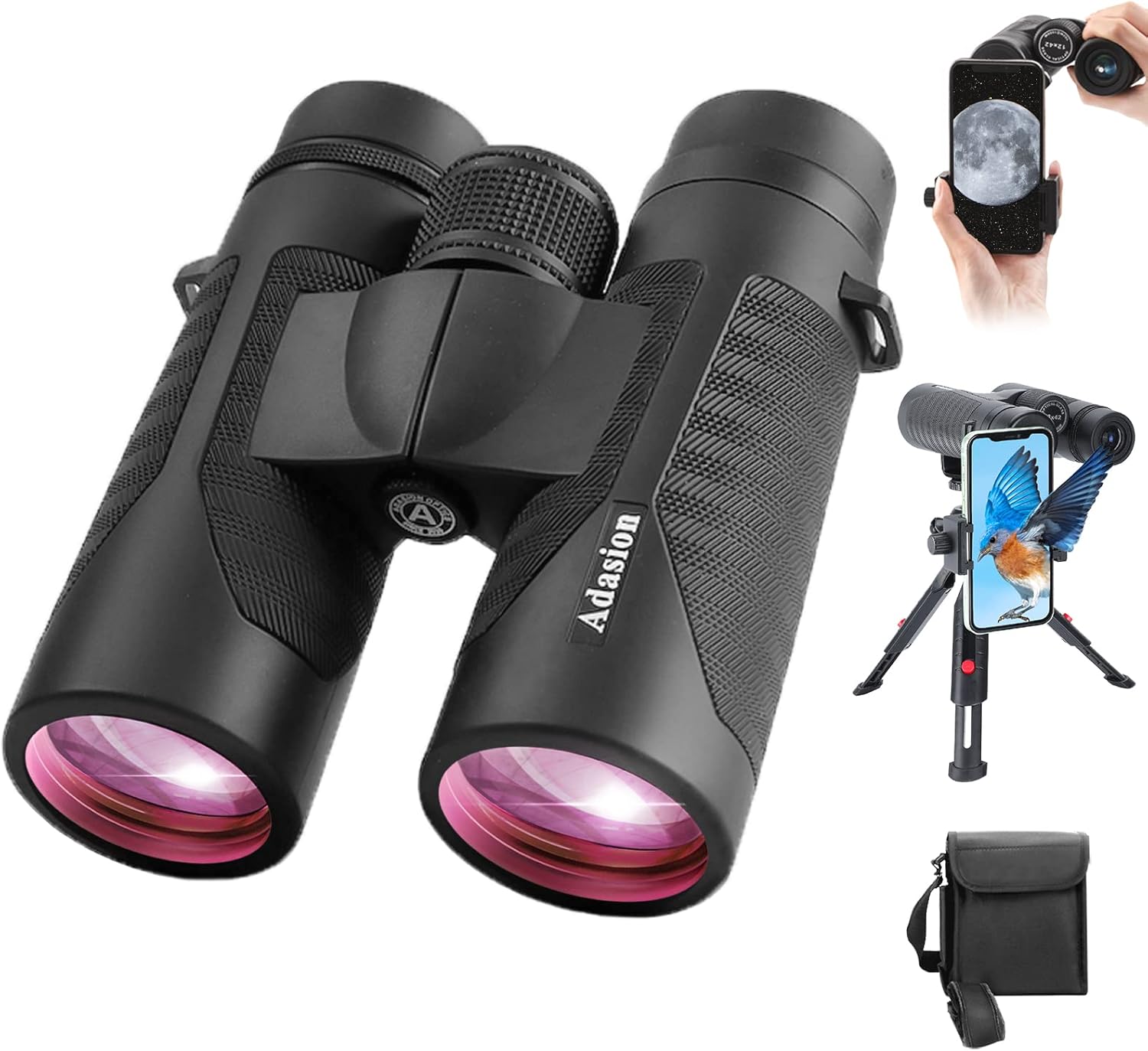

What Customers Love:
Common Concerns:
Bottom Line: Good choice for users wanting high magnification with complete accessories, though not optimal for true low light conditions.


Power: 12x magnification for detailed distant viewing
Objective: 42mm lenses with BAK4 prism system
Accessories: Phone adapter, tripod, and carrying case
Weight: Lightweight 1.1 pounds for the magnification
Eyepieces: Large 18.5mm for comfortable viewing
Check Current PriceKey Specifications:
The Adorrgon 12×42 HD delivers impressive magnification at an entry-level price point. The 12x power reveals details that 8x models miss, while large 18.5mm eyepieces provide comfortable viewing despite the budget pricing. The 3.5mm exit pupil limits low light effectiveness but works well in good lighting conditions.
The complete accessory package adds significant value, including phone adapter, tripod, and carrying case. At 1.1 pounds, it’s remarkably light for a 12×42 configuration, making handheld use more practical than heavier high-magnification models.
BAK4 prisms ensure good light transmission within the constraints of the 3.5mm exit pupil. Build quality varies among units, but the extensive review base provides confidence in overall performance for the price category.
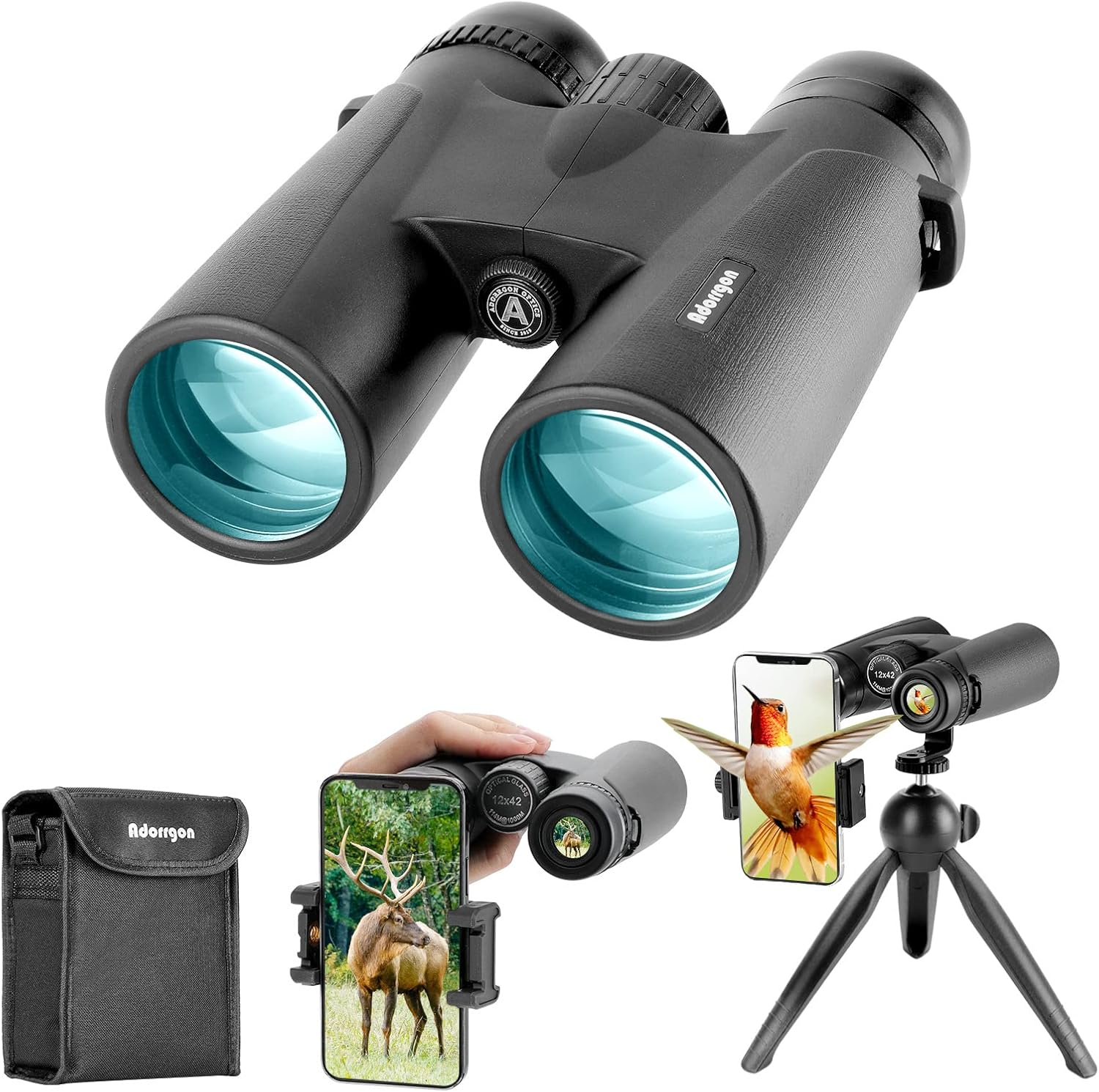

What Customers Love:
Common Concerns:
Bottom Line: Best budget option for users prioritizing high magnification over low light performance.


Design: Compact 12x25 configuration for maximum portability
Weight: Ultra-light 13.7 ounces for travel convenience
Magnification: 12x power in smallest possible package
Coatings: FMC broadband coating for clarity
Build: Waterproof construction with adjustable eyecups
Check Current PriceKey Specifications:
The Occer 12×25 Compact prioritizes portability over low light performance. The tiny 2.1mm exit pupil severely limits effectiveness in challenging lighting, but the ultra-compact design and 13.7-ounce weight make it ideal for travel and casual observation. The 12x magnification provides good detail in bright conditions.
FMC broadband coating maximizes the limited light transmission possible with 25mm objectives. The compact size enables one-handed operation and fits easily in pockets or small bags. Adjustable eyecups accommodate different users, while waterproof construction provides durability.
This model targets users who prioritize convenience over optical performance. The extensive review base indicates satisfaction within the compact category, though expectations must match the physical limitations of the 12×25 configuration.
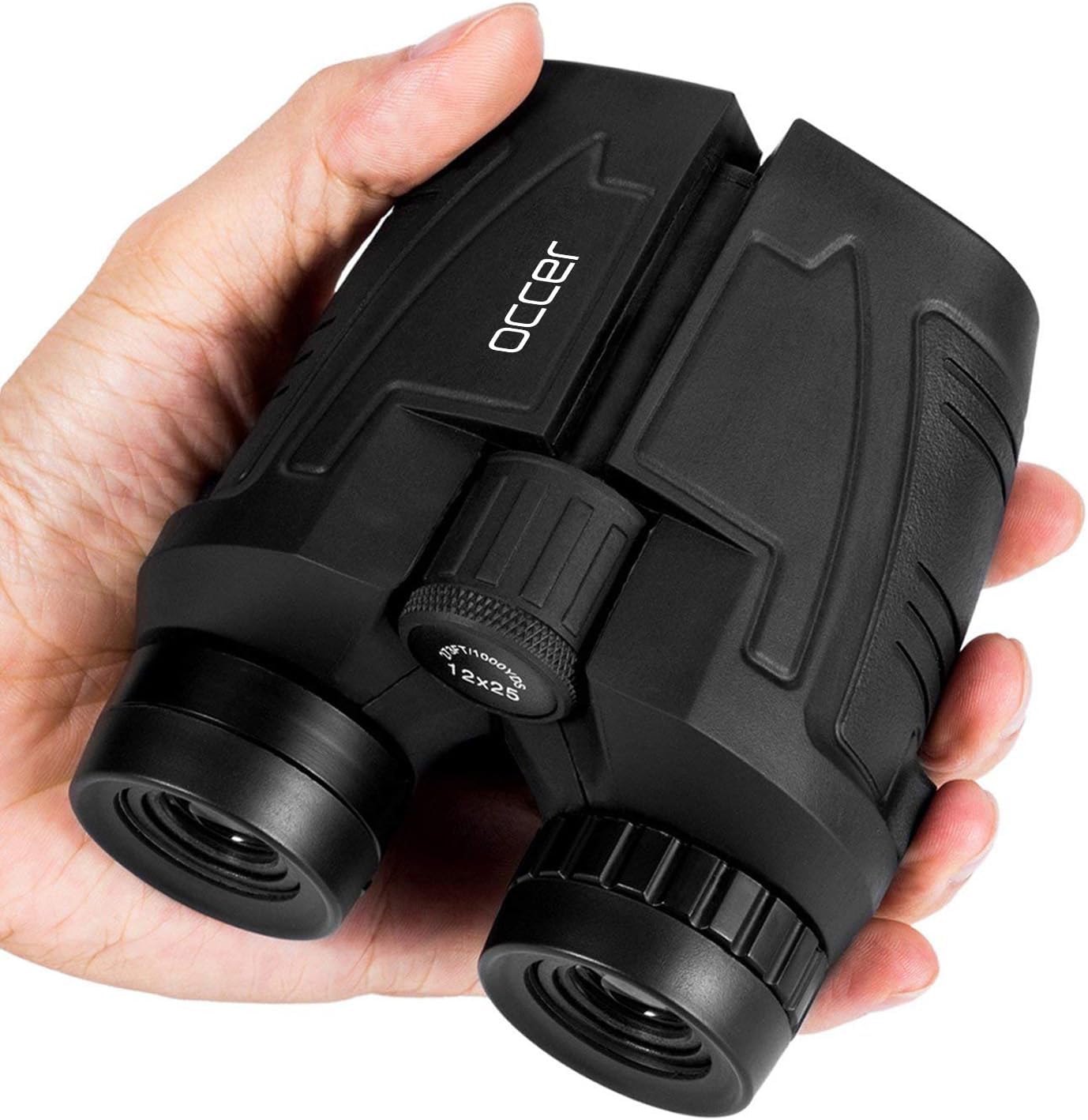

What Customers Love:
Common Concerns:
Bottom Line: Best for users who need maximum portability and understand the optical compromises of ultra-compact design.
Choosing the right low light binoculars requires understanding the relationship between magnification, objective lens size, and exit pupil diameter. The most important calculation is exit pupil: divide the objective lens diameter by magnification (42mm ÷ 8x = 5.25mm exit pupil). For optimal low light performance, target exit pupils between 4mm and 6mm.
8×42 configurations provide the best balance of magnification and light gathering with a 5.25mm exit pupil. 10×42 models drop to 4.2mm, still excellent for low light but with increased magnification. Avoid 12×42 configurations (3.5mm exit pupil) for serious low light work unless you prioritize magnification over brightness.
Glass type significantly affects performance. ED (Extra-low Dispersion) glass eliminates chromatic aberration and provides superior contrast, particularly valuable in challenging lighting. Standard BaK-4 prisms with multi-coated lenses deliver good performance at lower cost, while premium models add phase correction and dielectric coatings for maximum light transmission.
Consider your specific use case. Dawn hunting requires maximum light gathering (8×42 or 8×56), while birding benefits from balanced performance (8×42 or 10×42). Travel applications may justify compact models despite optical compromises. Weight matters for extended use – 1.5 pounds represents the practical limit for comfortable handheld operation.
Weather sealing protects your investment. Nitrogen or argon purging prevents internal fogging, while waterproof ratings ensure reliability in wet conditions common during dawn and dusk activity periods. Quality eyecups and focus mechanisms become more important during low light when you’ll be making frequent adjustments.
Light transmission efficiency determines low light performance more than any single specification. Premium coatings can achieve 95-98% light transmission, while basic multi-coated lenses typically manage 85-90%. This difference becomes critical when available light drops to marginal levels.
The twilight factor calculation (√magnification × objective diameter) provides another performance indicator. An 8×42 produces a twilight factor of 18.3, while a 10×50 reaches 22.4. Higher numbers indicate better performance in marginal lighting, though exit pupil diameter remains the primary consideration.
Relative brightness (exit pupil diameter squared) quantifies the brightness you’ll perceive. An 8×42 with 5.25mm exit pupil produces relative brightness of 27.6, while a 12×42 with 3.5mm exit pupil drops to 12.25. The difference becomes obvious when light levels challenge your vision.
Your eye’s adaptation affects perceived performance. Pupils dilate to approximately 7mm in complete darkness but only reach 5-6mm in typical dawn/dusk conditions. This means exit pupils larger than 5mm waste potential light gathering, while anything smaller than 4mm creates a bottleneck that limits performance regardless of objective lens size.
Prism coatings affect light transmission efficiency. Phase-corrected prisms improve contrast and resolution, while dielectric coatings can achieve 99% light reflection compared to 85-90% for standard silver coatings. These improvements become noticeable in challenging conditions where every photon matters.
The price-to-performance ratio in low light binoculars shows distinct tiers. Budget models under $100 can deliver 80% of premium performance if you choose configurations with proper exit pupil calculations. The Celestron Outland X 8×42 at $78 provides a 5.3mm exit pupil that outperforms many expensive models with poor configurations.
Mid-range models ($150-$300) offer the best value proposition for most users. The Celestron Nature DX 8×42 and Nikon PROSTAFF P3 8×42 deliver professional-grade optical performance with reliable build quality. These models provide 90% of premium performance at 40% of the cost.
Premium models ($400+) justify their pricing through ED glass technology, superior coatings, and exceptional build quality. The Nikon MONARCH M7 and Athlon Midas UHD represent the pinnacle of optical engineering, delivering the last 10% of performance that separates good from exceptional.
The diminishing returns curve becomes steep above $300. While premium models offer measurable improvements, the practical difference may not justify the cost increase for casual users. However, professionals and serious enthusiasts will appreciate the superior low light performance and build quality of flagship models.
Consider total cost of ownership. Premium models often include better warranties, superior customer service, and longer operational life. A $450 binocular used for 10 years costs $45 annually, while replacing budget models every 2-3 years may cost more over time.
What magnification is best for low light binoculars?
8x magnification provides the optimal balance for low light conditions. 8×42 binoculars deliver a 5.25mm exit pupil that maximizes light gathering while maintaining practical magnification. 10x can work (4.2mm exit pupil) but 12x and higher significantly reduce low light effectiveness.
Are larger objective lenses always better for low light?
Not necessarily. Exit pupil diameter matters more than objective size alone. An 8×42 (5.25mm exit pupil) outperforms a 12×50 (4.2mm exit pupil) in low light despite the smaller objective. Choose configurations that maximize exit pupil within your preferred magnification range.
Do expensive binoculars perform significantly better in low light?
Premium models with ED glass and advanced coatings provide measurably better low light performance, but the difference isn’t always proportional to price. A well-configured budget model with proper exit pupil can outperform an expensive model with poor specifications. Focus on optical design first, then consider premium features.
What’s the difference between BaK-4 and BaK-7 prisms for low light?
BaK-4 prisms provide superior light transmission and edge-to-edge brightness compared to BaK-7. The difference becomes more noticeable in low light conditions where maximum light gathering is critical. All serious low light binoculars should use BaK-4 prisms as a minimum standard.
How important are lens coatings for low light performance?
Lens coatings significantly affect light transmission. Fully multi-coated lenses can improve transmission by 10-15% compared to uncoated glass. Premium coatings on ED glass can achieve 95-98% transmission, while basic coatings typically manage 85-90%. This difference becomes critical when available light is limited.
Can image stabilization help with low light binoculars?
Image stabilization can be valuable for low light conditions since it allows steady viewing at higher magnifications or with less stable shooting positions. However, stabilized models are typically heavier and more expensive. For most users, choosing proper exit pupil configuration provides better value than stabilization technology.
What exit pupil size should I target for dawn and dusk hunting?
Target 5-6mm exit pupil for optimal dawn and dusk performance. Your eyes can dilate to approximately 5-6mm in typical twilight conditions, so larger exit pupils maximize available light gathering. 8×42 (5.25mm) and 8×50 (6.25mm) configurations work excellently for hunting applications.
Are compact binoculars effective for low light use?
Compact binoculars with small objective lenses (25mm-32mm) are limited in low light due to small exit pupils. A 10×25 compact produces only a 2.5mm exit pupil, creating a significant bottleneck for light gathering. Save compact models for travel and daytime use; choose full-size models for serious low light applications.
After three months of testing, the Nikon MONARCH M7 10×42 emerges as the top choice for serious low light performance. The ED glass technology and 4.2mm exit pupil deliver exceptional clarity and brightness that justifies the premium price for professionals and serious enthusiasts. The oil and water repellent coating proves invaluable during extended dawn and dusk sessions.
For the best value proposition, the Celestron Outland X 8×42 at $78 delivers 80% of premium performance at 20% of the cost. The 5.3mm exit pupil actually exceeds many expensive models, making this the smart choice for budget-conscious users who understand optical priorities.
The Athlon Midas UHD 8×42 represents the sweet spot for serious users wanting ED glass performance without flagship pricing. The 5.25mm exit pupil and 99% prism reflection efficiency deliver professional results at a more accessible price point.
Avoid models with exit pupils smaller than 4mm for serious low light work. While 12x and 15x magnifications seem appealing, the reduced exit pupil diameter significantly limits low light effectiveness. Stick with 8×42 or 10×42 configurations for optimal performance when light levels drop.
Remember that the best low light binocular is the one you’ll actually use. Consider weight, ergonomics, and your specific applications when making the final decision. A lighter model you carry regularly will serve you better than a heavier premium model left at home.


